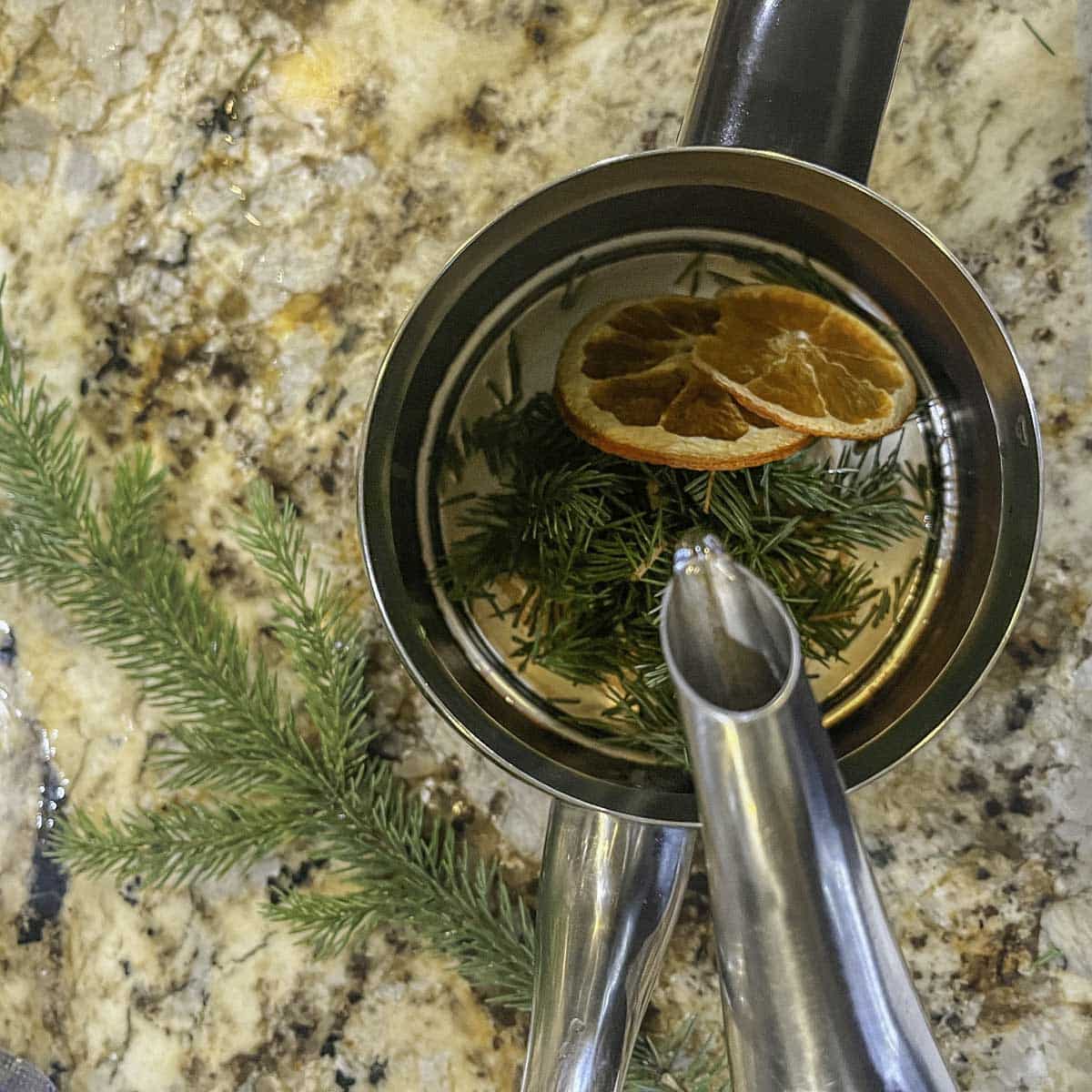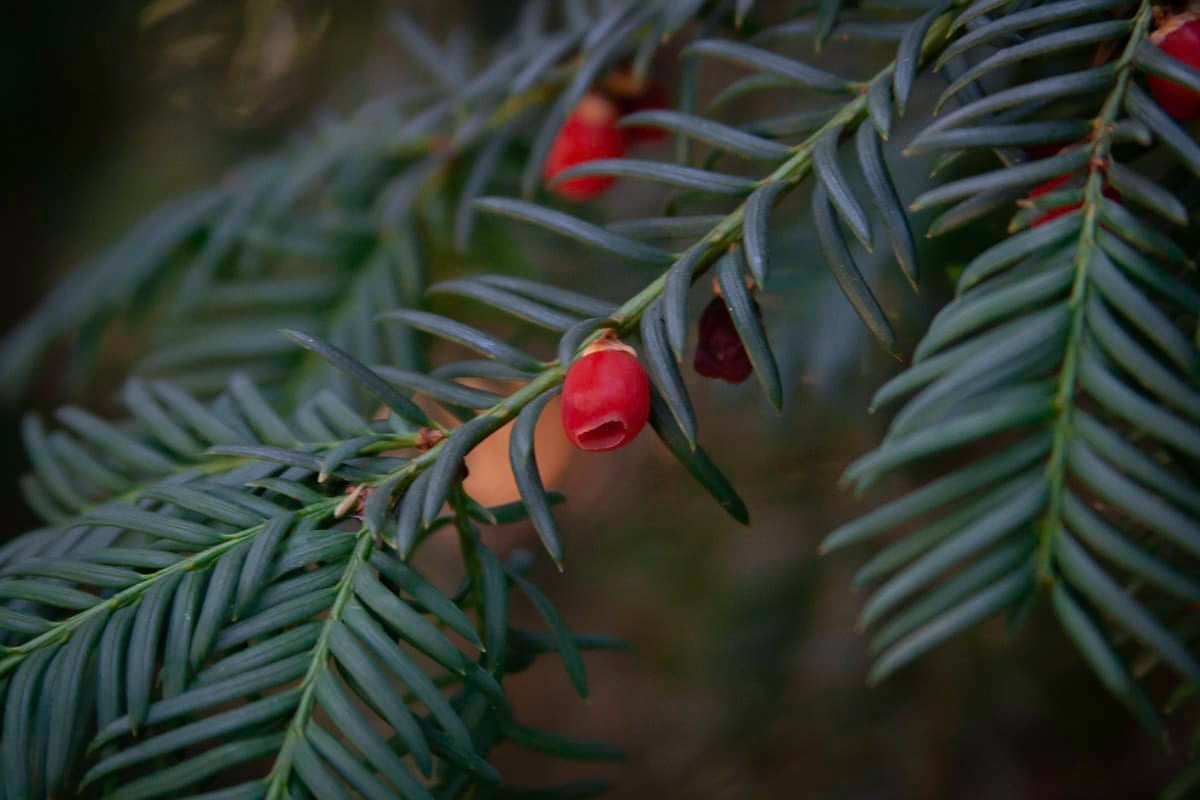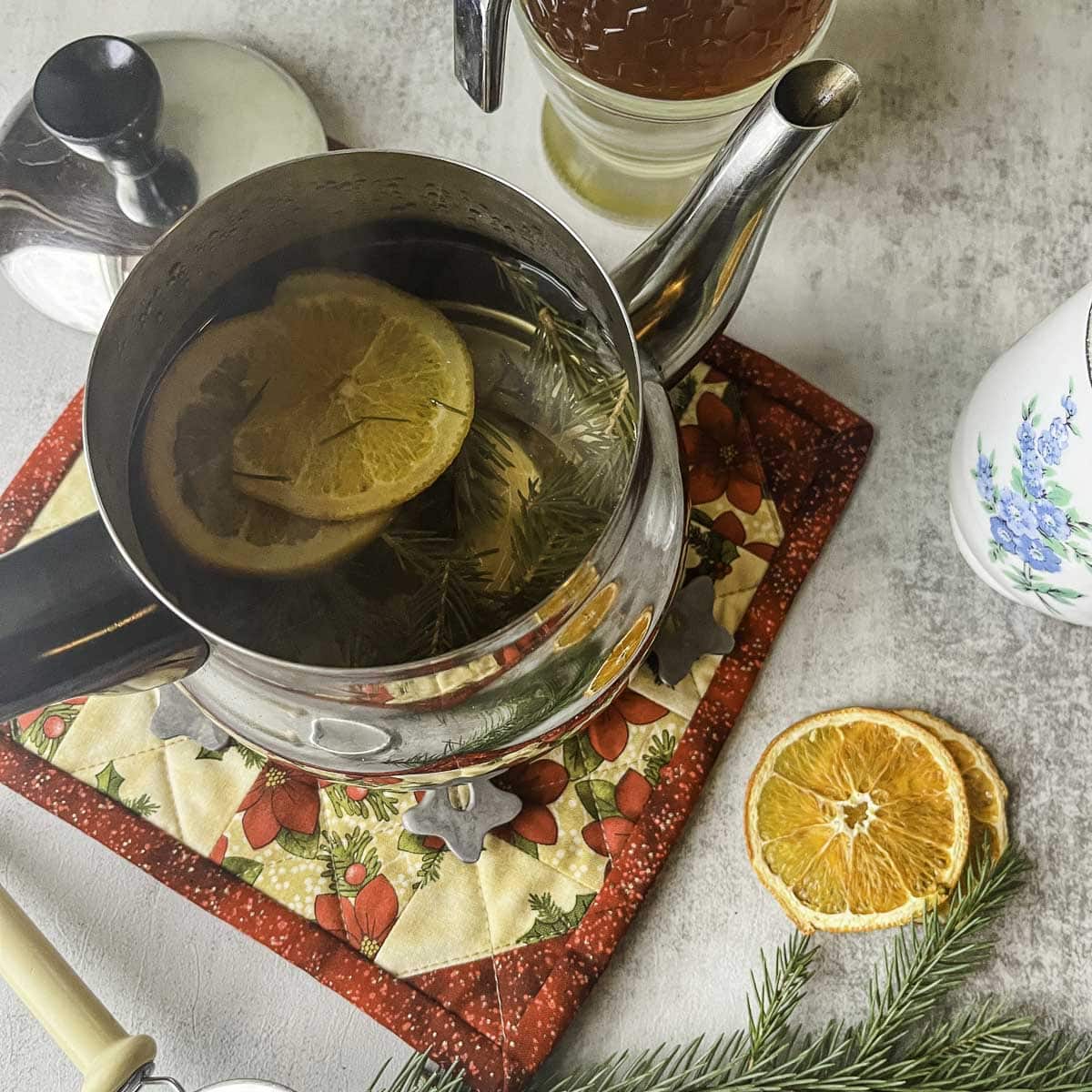Pine needle tea is a refreshing and citrusy tea with many health benefits! I like to steep the needles with cinnamon, juniper berries, cloves, cardamom, and dehydrated orange slices. You can have Christmas in a cup, any time of year!

If you know me at all, you know one of my favorite pastimes in Montana is foraging! The good Lord has given us (and the animals) so many berries, plants, and mushrooms to harvest (elderberries, chokecherries, and huckleberries to name a few). Although foraging options are limited in the winter, there are always the evergreens!
So this holiday season, snuggle up next to a warm fire and sip on a warm and refreshing cup of pine needle tea. Not only is pine needle tea tasty, but it has many health benefits!
Jump to:
🫖 Pine Needle Tea Benefits
Here in Montana, we have lots of spruce, Douglas fir, lodgepole, and ponderosa pines. We also have the gorgeous larch, a deciduous tree that turns a beautiful gold color in the fall and sheds its needles in the winter.
Because there are studies that show ponderosa pine is toxic, especially to pregnant women, I recommend steeping needles from spruce or fir.
Pine needle tea benefits are numerous! Here are just some of the benefits found in pine needle tea...
- Pine needle tea, similar to simmer pots, can leave your house smelling like Christmas as it steeps.
- Pine needle tea can give your immune system a boost, especially during the cold and flu season.
- Pine tea has an insane amount of vitamin C (4-5 times as much as a glass of orange juice). This may explain why pine tea was once used to stave off scurvy!
- This yummy tea is also rich in vitamin A, which you need for your eyesight. I don't know about you, but I can sure use some of that!
- Pine needle tea can also help alleviate chest congestion and soothe sore throats. Because it's an expectorant, it can ease other respiratory issues as well!
- The tea also contains antioxidants, which reduce harmful free radicals.
- In a 2017 study, essential oils made with pine needles, cones, and twigs were found to have antiproliferative effects on cancer cells.
- It also helps to reduce inflammation, blood pressure, and more!
🔖 Ingredients & Substitutions

- Pine Needles: There are many types of pine needles that can be used to make pine needle tea. I have tried lodgepole, Douglas fir, and spruce. If you don't live in the middle of the forest like some of us, you can purchase pine needles online.
- Sweetener: Honey is a great sweetening option. It's natural and has many health benefits. Honey syrup is even better! If you prefer sugar, try my sugar cubes for tea.
- Spices & Other Flavoring: I recommend trying pine needle tea plain first, then adding any of the following to enhance the flavor: Citrus slices, cardamom pods, whole cloves, cinnamon sticks, and ginger.
🍯 Helpful Tools
- Teapot: You'll need a teapot to simmer the tea. I love my Turkish teapot set and use it to brew loose tea all the time! Water is boiled in the bottom portion and then poured over loose tea in the teapot. The tea is then poured from the teapot. For those who prefer a weaker tea, water from the bottom pot is also poured into the cup.
- Tea Infuser: If you want to brew the tea by the cup, use a tea infuser instead.
- Honey Dispenser: If you want to feel extra fancy, you can serve the tea with honey in this beautiful honey dispenser.

☕️ How to Make Pine Needle Tea
Step 1: Wash and then chop spruce branches (or other edible pine needles) to measure ½ cup. Add the needles and a few orange slices to a teapot. Pour two cups of boiling water into the teapot.


Pro Tip: Don't include twigs or thicker branches. Instead, strip or cut the needles off the branch using kitchen shears.
Step 2: Simmer the tea over low heat for 15 minutes to extract the flavor and beneficial properties of the pine branches.


Step 3: Strain the tea into a teacup and sweeten it with honey, brown sugar, or the sweetener of your choice. Enjoy!



Optional Step: Try adding mulling spices or your favorite spices to the teapot for an even more delicious cup of pine tea!

☠️ Pine Needle Tea Dangers
If you live in the mountains, you probably have access to pine needles. However, you need to know which conifers are edible and which ones are poisonous.
There are so many species of pine... eastern white pine, Norfolk Island pine, and Australian pine, to name a few. Then there's the common juniper, cypress, and yew.
Some of these pines, especially the common yew, are toxic and should not be used to make pine needle tea! While some may cause stomach upset, others can damage your kidneys or even cause death. For this reason, I suggest that you stick with the ones that are safe, like spruce and fir.
Would you like to save this recipe?

Ponderosa Pine & Lodgepole Pine
There is mixed information online regarding the safety of consuming pine tea made with ponderosa pine, especially during pregnancy. In one study, pregnant cattle in their 3rd trimester, who ate large amounts of ponderosa pine needles (4 to 6 pounds), aborted their babies.
Although I have had lodgepole pine tea and pine needle soda without any issues, you should proceed with caution and avoid pine needle tea made with these two types of pines, especially if you're pregnant or nursing.
Needle Identification: Lodgepole needles are 1-3" long and grow in bundles of 2, while Ponderosa pines are longer than lodgepole needles. They are 5-10" long and grow in bundles of 3.
Fun Fact: An interesting fact about lodgepole pinecones is that they stay closed until the heat from a forest fire causes the pinecones to open and release their seeds. This process helps to start new growth after a forest fire.


🌲 Edible Pine Trees
There are many species of pine. In this post, I will be referring to the ones that grow where I live. I encourage you to do your homework and discover what species of pines grow where you live before you go foraging!
Spruce
Pine trees are usually identified by their size, needles, bark, and cones. In this post, I'll mostly refer to their needles, which are pretty easy to distinguish from one another.

I love spruce! It's a part of the pine family. In the past, I've used fresh spruce tips to make spruce tip pesto. I've also made delicious spruce shortbread cookies. I had planned on sharing the recipe in a future post. Unfortunately, I can't find the recipe anywhere, just the photos. 😬

I also use spruce to make spruce wine and mead (wine made with honey instead of sugar) and spruce shrub. Spruce tips can also be used to make pine needle soda!
Needle Identification: Spruce needles are ⅝ to 1" long. They are very pointy and sharp, and you can roll the needles between your fingers. In other words, they're not flat. If foraging for the needles is a painful experience, there's a good chance you've got yourself a spruce!


Douglas Fir
Needle Identification: The needles on a Douglas Fir are soft to the touch, flat, and ¾ to 1 ¼" long. It's an evergreen conifer in the pine family, Pinaceae. This means Douglas Fir needles can also be used to make pine needle tea, so drink up!


🤷🏻♀️ FAQs
Yes, you can. The most important thing to remember is to properly identify the tree first to make sure it's not toxic. Yew, for example, looks like pine but is in fact a toxic evergreen shrub.
Add fresh or freshly dried (green) pine needles to a teapot and cover it with boiling water. Steep the tea for at least 15 minutes then strain it into your cup and sweeten it with honey. For a more festive drink, you can add mulling spices or dehydrated citrus slices.
Anyone who suspects that they might have an allergy to pine or pollen (since pine trees are often covered in pollen dust) should not consume pine needle tea.
Another group that should avoid pine needle tea is pregnant ladies, especially tea made with ponderosa pine. There have been documented cases of cows aborting their babies after consuming a large amount of ponderosa pine needles.
Technically, you can snip off a few sprigs of your Christmas tree (from the back) to brew up some pine needle tea. It really depends on if the type of tree you have is edible or not. You also need to confirm that the Christmas tree is not treated or sprayed with any chemicals.
Pine needle tea is light, minty, and citrusy. The subtle flavor can be enhanced by steeping herbs and spices along with pine needles.
👩🏼🍳 Pro Tips
- You can also infuse the pine needles in a mug with a built-in infuser or use these fillable, disposable tea bags. I love them!
- When foraging for needles, use the fresh needles on the ends of the branches instead of the older ones closer to the center of the tree. The older ones can be a little bitter, but will give you a stronger pine tea.
- I've always preferred black tea to green or clear tea. If this is you, try adding brown sugar. It's a great way to sweeten the tea and give it a darker color!

🫖 Other Tea Recipes
You may also want to try these other yummy tea recipes!
🍇 Related Recipes
📖 Recipe

Pine Needle Tea Benefits & Recipe
Ingredients
- ½ cup spruce or Douglas Fir needles (chopped)
- 2 cups water
- 2 orange or lemon slices
- honey, or sweetener of choice (optional)
Optional Ingredients
- 3 cardamom pods
- 3 whole cloves
- ¼ inch cinnamon stick
- 3 juniper berries
- 1 slice ginger
Instructions
- Wash and then chop spruce branches (or other edible pine needles) to measure ½ cup. Add the needles and a few orange slices to a teapot. Pour two cups of boiling water into the teapot.
- Simmer the tea over low heat for 15 minutes to extract the flavor and beneficial properties of the pine branches.
- Strain the tea into a teacup and sweeten it with honey, brown sugar, or the sweetener of your choice. Enjoy!
Optional Step
- Try adding mulling spices or your favorite spices to the teapot for an even more delicious cup of pine tea!
Notes
- Don't include twigs or thicker branches. Instead, strip or cut the needles off of the branch using kitchen shears.
- You can also infuse the pine needles in a mug with a built-in infuser or use these fillable, disposable tea bags. I love them!
- When foraging needles, use the fresh needles on the ends of the branches instead of the older ones closer to the center of the tree. The older ones can be a little bitter but will give you a stronger tea.
- I've always preferred black tea to green or clear tea. If this is you, try adding brown sugar. It's a great way to sweeten the tea and give it a darker color!







Sarah says
This is all such great info. Thanks for sharing!
Hilda Sterner says
Thank you, Sarah! I love sharing information, maybe I should have been a teacher?
Brevak says
Thanks. Have an abundance of pine trees in our yard and pastures in northern Wisconsin! Excited to try this, however, I'm not an tea drinker.
Hilda Sterner says
Thanks, Brevak, I appreciate your comment. Even if you're not a tea drinker you can make it for someone who does like tea, right? 🙂
Dr Bonile Nomyayi (aka Jack-Oama) says
Useful information on pine needles tea. Simple and detailed !!
Hilda Sterner says
Thank you for the review!